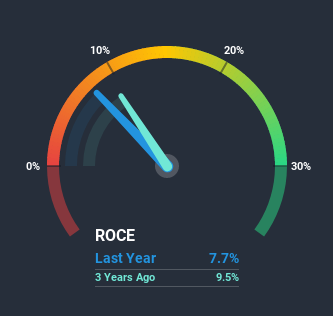What Do The Returns On Capital At DISH Network (NASDAQ:DISH) Tell Us?

What are the early trends we should look for to identify a stock that could multiply in value over the long term? One common approach is to try and find a company with returns on capital employed (ROCE) that are increasing, in conjunction with a growing amount of capital employed. Ultimately, this demonstrates that it's a business that is reinvesting profits at increasing rates of return. Having said that, from a first glance at DISH Network (NASDAQ:DISH) we aren't jumping out of our chairs at how returns are trending, but let's have a deeper look.
Return On Capital Employed (ROCE): What is it?
For those who don't know, ROCE is a measure of a company's yearly pre-tax profit (its return), relative to the capital employed in the business. Analysts use this formula to calculate it for DISH Network:
Return on Capital Employed = Earnings Before Interest and Tax (EBIT) ÷ (Total Assets - Current Liabilities)
0.077 = US$2.1b ÷ (US$33b - US$5.8b) (Based on the trailing twelve months to June 2020).
Therefore, DISH Network has an ROCE of 7.7%. In absolute terms, that's a low return and it also under-performs the Media industry average of 9.6%.
View our latest analysis for DISH Network
Above you can see how the current ROCE for DISH Network compares to its prior returns on capital, but there's only so much you can tell from the past. If you're interested, you can view the analysts predictions in our free report on analyst forecasts for the company.
What Does the ROCE Trend For DISH Network Tell Us?
We weren't thrilled with the trend because DISH Network's ROCE has reduced by 31% over the last five years, while the business employed 59% more capital. Usually this isn't ideal, but given DISH Network conducted a capital raising before their most recent earnings announcement, that would've likely contributed, at least partially, to the increased capital employed figure. The funds raised likely haven't been put to work yet so it's worth watching what happens in the future with DISH Network's earnings and if they change as a result from the capital raise.
The Bottom Line On DISH Network's ROCE
Bringing it all together, while we're somewhat encouraged by DISH Network's reinvestment in its own business, we're aware that returns are shrinking. And in the last five years, the stock has given away 56% so the market doesn't look too hopeful on these trends strengthening any time soon. On the whole, we aren't too inspired by the underlying trends and we think there may be better chances of finding a multi-bagger elsewhere.
If you want to continue researching DISH Network, you might be interested to know about the 4 warning signs that our analysis has discovered.
While DISH Network may not currently earn the highest returns, we've compiled a list of companies that currently earn more than 25% return on equity. Check out this free list here.
This article by Simply Wall St is general in nature. It does not constitute a recommendation to buy or sell any stock, and does not take account of your objectives, or your financial situation. We aim to bring you long-term focused analysis driven by fundamental data. Note that our analysis may not factor in the latest price-sensitive company announcements or qualitative material. Simply Wall St has no position in any stocks mentioned.
Have feedback on this article? Concerned about the content? Get in touch with us directly. Alternatively, email editorial-team@simplywallst.com.

 Yahoo News
Yahoo News 

